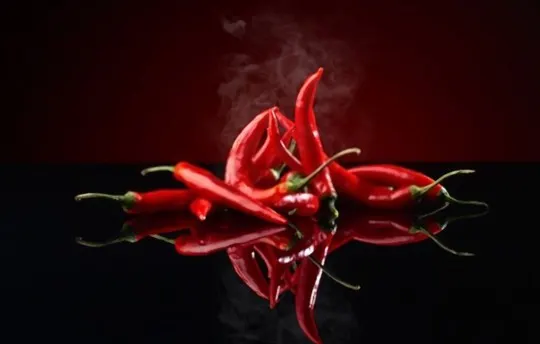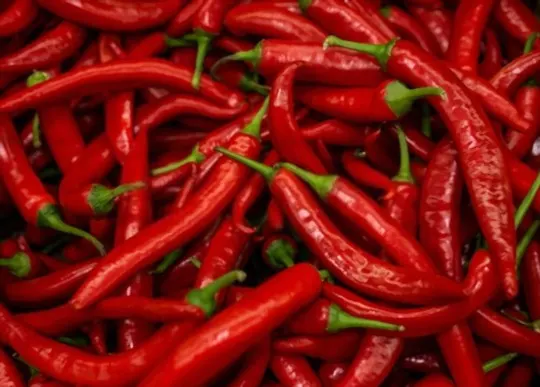In the great kitchen showdown, green chili tangles with red chili. Both pack a punch. The difference isn’t just color. It’s about flavor, heat, and how they’re used in dishes.
We’ve all been there, deciding what chili to add to our cooking pot. It’s a decision that can make or break a meal.
Green chili brings a bright, sometimes fiery kick, perfect for waking up those enchiladas. Red chili? It’s all about depth, a slow burn that builds, ideal in stews and sauces.
Remember that time we thought swapping one for the other wouldn’t matter. Spoiler: it did. Big time.
What are Green Chilies?

Green chilies, a type of chili pepper, are unripe hot peppers that are harvested before they turn red.
They have a mild to moderate level of heat and a distinct grassy flavor.
Green chilies are often used in Southwestern cuisine, particularly in Mexican dishes such as salsa verde and green chili stew.
They can be roasted, grilled, fried, or eaten raw and can be found fresh or canned at most grocery stores.
When compared to their red counterparts, green chilies have a milder heat with a crisp and slightly bitter taste.
The difference in color also impacts the nutrient content – green chilies contain more vitamin C while red chilies have more vitamin A.
Green chilies also contain a compound called capsaicin which has been linked to health benefits such as pain relief and improved digestion.
It’s important to note that not all green chilies are created equal – there are many different varieties with varying levels of heat and flavor profiles.
Some common types include Anaheim, poblano, serrano, and jalapeño peppers.
It’s best to experiment with different types to find the one that suits your palate the most.
What are Red Chilies?

Red chilies are a type of pepper originating from the capsicum family.
These peppers, also known as red hot chili peppers, come in various sizes and have a vibrant red color when ripe.
They are widely used in cooking for their fiery taste and contribute to several health benefits.
Red chilies contain a high amount of Vitamin C, fiber, and antioxidants that help in preventing chronic diseases.
They are popularly used as spices in Asian and Mexican cuisines due to their pungent flavor and spiciness which adds depth to dishes.
In addition to being used for culinary purposes, red chilies also have medicinal uses such as preventing blood clots, reducing pain, and easing sore throats.
Differences Between Green Chilies and Red Chilies

Green chili and red chili differ in many ways, starting with their color, flavor, and ripeness.
Green chilies are harvested before they reach full maturity and have a milder spiciness than the red ones.
Whereas, red chilies are left to ripen on the plant till they turn red and become much hotter and smokier in taste.
Additionally, green chilies contain more vitamin C than the red ones.
However, when it comes to cooking with these vegetables, both types of chili peppers can be used interchangeably for different dishes based on their unique flavors and heat levels.
Color and Ripeness
Green and red chilies are not just different in color but also in their ripeness.
The color difference of chilies indicates their level of maturity, with green ones being under-ripe and red ones being fully ripe.
Green chilies are firmer, less sweet, and have a grassier flavor compared to the sweeter taste and fruity aroma of red ones.
When it comes to spiciness, green chilies tend to be hotter due to their high content of capsaicin.
Red chilies, on the other hand, have a milder spiciness and are commonly used for adding flavor rather than heat.
However, the spiciness also depends on the variety of chili pepper.
The ripeness level of chilies can affect not only their taste but also their nutrition profile.
While both green and red chilies are low in calories and rich in vitamins C and A, red ones tend to have higher levels of antioxidants due to their longer exposure to sunlight during the ripening process.
In summary, there is a clear distinction between green and red chilies based on their color and ripeness level.
While green chilies are more pungent in taste and spicier than red ones, fully ripe red chilies offer a sweeter flavor profile with an added nutritional benefit of higher antioxidant content.
Flavor and Heat Level
Green chili and red chili vary in Flavor and Heat Level.
Green chilies are slightly less spicy but have a fresher flavor and are often used in dishes that require a bright, fresh taste.
Red chilies are spicier with a more intense flavor and are commonly used in hearty dishes or as a garnish.
The heat level of both types of chilies varies depending on the type and maturity of the pepper.
Culinary Uses
The varied culinary applications of green and red chili make them indispensable in many kitchens.
From salsas, stews, soups and sauces to marinades, rubs and garnishes, both types of chili peppers add distinct flavor and heat intensity to dishes.
Notably, green chilies are often preferred in Mexican cuisine for their mild fruity taste while red chilies are used for spicier Asian-inspired dishes such as curries and stir-frys.
But despite their differences, both peppers can be used interchangeably or combined to create complex flavors.
Nutritional Content
When it comes to the nutritional content of green chili and red chili, they differ slightly.
Both types of chilies are low in calories, with around 30 kcal per 100g, but green chilies tend to be higher in vitamin C than red chilies.
On the other hand, red chilies contain more vitamin A than green chilies.
Additionally, both types are a good source of potassium and fiber, providing various health benefits.
Apart from vitamin content, some studies suggest that capsaicin, the compound responsible for heat in chilies, may have potential anti-inflammatory and pain-relieving effects on the body.
However, further research is needed to determine its full impact on human health.
In addition to this commonality between the two types of chilies, they also vary in terms of taste and spice level.
While green chilies feature a fresh and mild flavor with a moderate level of heat, red chilies have a stronger flavor profile with intense spiciness that can range from mildly hot to extremely hot depending upon the type of chili pepper used.
Similarities Between Green Chilies and Red Chilies

Green and red chilies have a lot in common.
Both belong to the same family, Capsicum annuum, are used widely as spices, and add fiery heat to dishes.
They have similar health benefits too, as both contain capsaicin that can aid digestion and boost metabolism.
Both also come in different types with varying levels of spiciness.
Besides their similarities, green and red chilies do differ in their taste and appearance due to the level of ripeness.
Green chilies are immature and harvested before they fully ripen, providing a fresh, slightly bitter flavor and crunchy texture.
Whereas red chilies are left on the plant longer until they mature and turn red, giving them a sweeter taste and softer flesh.
Despite the differences in their taste and appearance based on maturity level, both green and red chilies share many similarities that make them popular choices among cooking enthusiasts.
What Dishes Are Green Chilies and Red Chilies Used In?
Green and red chilies are common ingredients in various dishes worldwide.
These peppers differ in taste and heat levels, making them useful for various cuisines.
Here are some dishes where green and red chilies are commonly used:
- Green chilies add zing to Indian curries such as sambar, dal tadka, and chicken tikka masala.
- Red chilies give a fiery taste to Thai cuisine like Tom Yum soup, Pad Thai noodles, and green curry.
- Mexican food relies heavily on green chilies to flavor their sauces, salsas, and stews.
- In Chinese cuisine, Sichuan-style dishes like Mapo tofu use red chili paste for spice.
- Pakistani street food favorite Bun Kebab uses both green and red chili sauce for a spicy kick.
Apart from traditional cuisine, these peppers find their use in fusion foods such as sandwiches or burgers.
The tangy tomato and chili sauce make up the base in many Indo-Chinese fast-food favorites like Chilli Paneer or Manchurian.
The versatility of these peppers cannot be understated.
Both Green and Red Chili have different culinary applications.
Chefs prefer green chilies when they need a milder flavor with lesser heat; In contrast, red chilies offer robust spiciness suitable for more strong-tasting dishes.
Cooking Tips and Pairings for Green Chilies and Red Chilies
Green Chilies and Red Chilies have distinct differences that affect their optimal method of use in cooking.
Here are some valuable tips and pairings for using these two types of chilies:
- For Green Chilies, use them raw or cooked depending on the recipe’s requirement. In Indian cooking, where Green chilies are used mostly, they are cut vertically or horizontally and added to dishes. When preparing Mexican recipes, remove the seeds from Green Chilies and roast them to bring out their flavor.
- For Red Chilies, they can be used fresh or in dried form. As Red Chilies matured from Green ones, their heat levels evolved and prolonged. When fresh, they add moderate heat to recipes while dried red chilies add a smoky flavor to any dish; soaking in hot water is essential before adding them to the food.
Both Green and Red Chili pair well with different ingredients including coriander, cumin seeds, turmeric powder, onion, garlic cloves, tomatoes among others.
It’s worthy of mentioning that while green chilies are chili peppers that haven’t turned red yet when ripe, red chilies result when green chiles ripen over time; hence both have differences that make it essential to choose suitable pairs for recipes you prepare.
Conclusion
The differences between green chili and red chili are evident in their taste, heat, and application.
While green chilies tend to be milder and have a slightly tangy flavor, red chilies pack a punch and bring more spice to the table.
Green chilies are versatile and can be used in salads, dressings, and garnishes, while red chilies work well in curries, stews, and sauces.
Overall, when it comes to choosing between green chili vs red chili, one should consider the recipe requirements carefully.
The flavor profile needed, level of heat desired, and color preference will all influence which type of chili would work best in a particular dish.
In summary, both green chili and red chili have distinct flavors that can elevate any meal they are added to but come with unique characteristics that must be considered before use.

Green Chili vs Red Chili: What’s the Difference?
Ingredients
- Green Chili
- Red Chili
Instructions
- Choose between green chili and red chili based on your preference for flavor and heat level.
- Incorporate the chosen chili into your dish, adjusting the quantity to achieve the desired spiciness.
- Follow your recipe’s instructions for preparing and cooking the chili, ensuring it is properly cleaned and chopped.
- Add the chili to your dish at the appropriate stage, allowing it to infuse its distinct flavor into the recipe.
- Taste and adjust the seasoning as needed, considering the intensity of the chili’s heat.
- Serve your dish and savor the unique taste and heat characteristics of either green chili or red chili.
- Explore different recipes and experiment with the versatility of these chilies to enhance your culinary creations.

Andrew Gray is a seasoned food writer and blogger with a wealth of experience in the restaurant and catering industries. With a passion for all things delicious, Andrew has honed his culinary expertise through his work as a personal chef and caterer.
His love for food led him to venture into food writing, where he has contributed to various online publications, sharing his knowledge and insights on the culinary world. As the proud owner of AmericasRestaurant.com, Andrew covers a wide range of topics, including recipes, restaurant reviews, product recommendations, and culinary tips.
Through his website, he aims to inspire and educate fellow food enthusiasts, offering a comprehensive resource for all things food-related.

Leave a comment